Beijing
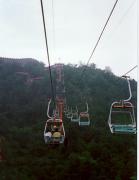
| The nice thing about the Great Wall at the Mutianyu site is that
one can take a cable car up (a common feature of Chinese tourist
attractions) then slide back down.
| 
|
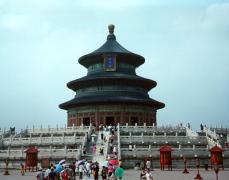
| The Temple of Heaven.
|
The northwest
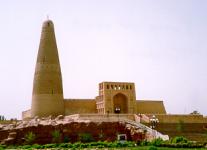
| The northwestern part of China is basically Muslim.
|
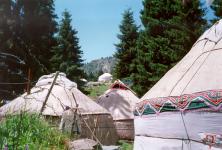
| It also has people from neighboring Kazakhstan.
|
China is all officially in the same time zone, so people in
the far west (a few thousand miles west of Beijing) run on two
clocks - "Beijing time" and "regular time".
This makes it a bit confusing, as some businesses seem to operate
on Beijing time, opening when it is dark and closing when the sun is
still high, but most operate on "real time", which is
four hours behind.
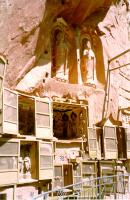
| The Buddhist cave art of Bingling Monastery.
|
Xiahe
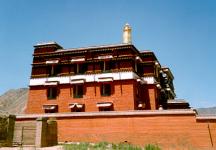
| Labrang Lamasery in Xiahe is the largest Tibetan monastery outside of
Tibet proper and is a major pilgrimage site. It is ringed by a couple
of kilometers of prayer wheels. Chinese tourists seem to be more interested
in Chinese historical sites than in ethnic minorities, so most tourist
facilities in Xiahe were geared towards Western tourists, especially
backpackers.
| 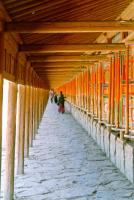
|
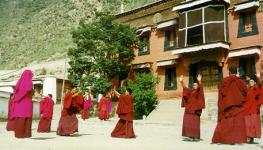
| Young monks are trained in the arts of
painting, singing, and dancing.
|
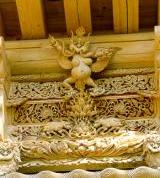
| The woodwork over the doors was often intricate.
|
Xi'an
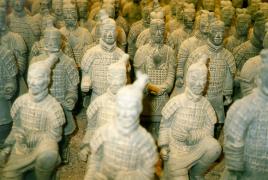
| The two things one must do in Xi'an is see the terracotta warriors
and eat a jiaotze banquet. Da Fe Chang restaurant offers such meals,
where you can try 18-20 varieties of jiaotze.
| 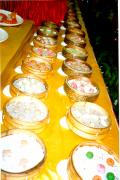
|
Yunnan
| Many places in western Yunnan province had torch festivals while I was
there. When I arrived in Dali just before sunset, the streets were full of
tourists running around with torches, uncertain where to go. When the
town got dark, enormous five-foot-high free-standing torches were lit in
the middle of the streets, and tourists and townspeople lit their own
hand-held torches. The locals threw a white powder into their torches to
make them flare up, usually at cute girls and other hapless passersby.
They aimed the flares at people's legs, so the right side of my (and probably
everyone else's) pants were covered in soot.
| 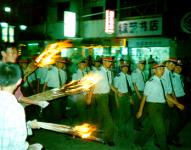
|
The next morning, I found that Dali is a beautifully-situated little
town with high hills on one side and a large lake on the other. The
Bai minority inhabits the older parts of this town. The newer part
caters to Chinese and Western tourists, especially backpackers.
One end has expensive boutique shops and the other is full of cafes
with western music or Tibetan themes, despite the absence of actual
Tibetans. I was pretty irritated at the western places, largely
because the name Dali can so easily be used in stupid puns for the
store names, like the "Salvador Dali Cafe". Lijiang, which is even
more heavily-touristed, does not have this problem.
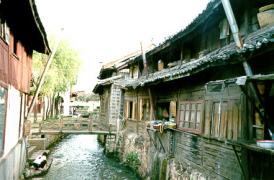
| Lijiang is a beautiful town in
northwestern Yunnan. It is a UNESCO World Heritage site and relies
heavily on tourist dollars, so the old picturesque part of town is
completely full of tourists interspersed with old Naxi women going
to markets and chatting with each other on street corners. The larger
streets in the old town looked a little too well-restored to look
natural.
|
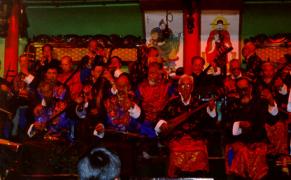
| One of the highlights of Lijiang is the Naxi Orchestra. They
are a group of old (80+ years) musicians who still play ancient
music based on Taoist scriptures.
|
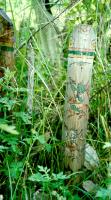
| The Dongba (Naxi) culture is related to Tibetan.
Walking on the outskirts of a large park, I discovered a huge cluster
of Dongba religious artifacts on the ground and hanging in trees.
It is apparently a place of active worship, with fresh sticks of
incense and bowls of food offerings nearby.
|
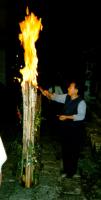
| Lijiang also happens to have a torch festival, which is much calmer
than Dali's.
|
Zhongdian
| Zhongdian is a Tibetan town at about 3200m
above sea level.
The Chinese government recently dubbed this extreme northwestern
corner of Yunnan province
"Shangri-la" (Xiang ge li la), after the novel by James
Hilton. They are making efforts to attract tourists who want to
see the perpetually snow-covered peaks and vast grasslands.
At the same time, they are trying to assimilate the Tibetans
by transplanting and subsidizing Han Chinese from the east to
live there. Like many of the towns in the area, the Chinese have
appended an ugly modern city full of concrete highrises to
a little Tibetan village.
| 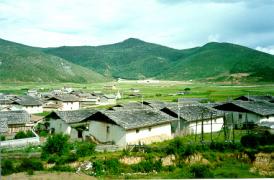
|

| The food scene seems to be dominated by yak
restaurants. These are easily recognized by the large chunks of
yak aging from the rafters, as well as the yak skulls and tails
arranged decoratively out front. I think they had daily deliveries
of entire butchered yaks (including the hooves and organs) dropped
on their doorsteps in giant wicker baskets.
|
| While I was in Zhongdian, the town was full
of Tibetan women selling expensive matsutake mushrooms to dealers
in the market. I saw large markets in several Tibetan towns
dedicated exclusively to the buying and selling of matsutakes.
These mushrooms grow in the hills from June to August, and
Tibetan women can sell them to dealers for about
$100 (US dollars) per half-kilo. These are immediately flown to
Japan where they may be triple that price.
| 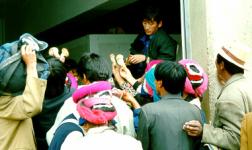
|
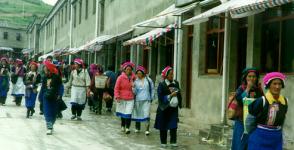
| The women wore bundles of brightly-colored yarn on their heads
and embroidered tops. They usually had blue aprons similar to the
Naxi.
|
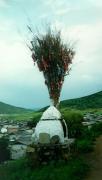 A juniper hearth and prayer flags near a hilltop monastery.
Tibetan Buddhism permeated the atmosphere all around the Tibetan
plateau. Many wore pendants containing a picture of the Panchen
Lama, second only to the Dalai Lama in authority. The Chinese
government supports the Panchen Lama, who lives in Beijing.
The government not only forces the Dalai Lama to live in exile,
his likeness is banned in China. Any photos of the Dalai Lama,
even a photo in your guidebook, is considered contraband and can
get you shipped home (note that newer editions of
guidebooks no longer contain his photo).
This seems to have made the scarce copies
of his image more wondrous. A tourist told me that he was
showing a small crowd of Tibetan men a tiny image of the young
Dalai Lama from his guidebook. When the men finally recognized
the young Lama, they removed their hats and stared at the photo.
I was walking around the grounds of a monastery that was closed,
but an old monk offered to let me into the main building. He
unlocked a tiny room all the way in the back, then flipped on the
lights. At the end of the room was a large poster of the Dalai
Lama from some peace rally, probably in America.
It was ringed by Christmas lights.
Obviously, this room could not be part of the official tour
of the grounds.
A juniper hearth and prayer flags near a hilltop monastery.
Tibetan Buddhism permeated the atmosphere all around the Tibetan
plateau. Many wore pendants containing a picture of the Panchen
Lama, second only to the Dalai Lama in authority. The Chinese
government supports the Panchen Lama, who lives in Beijing.
The government not only forces the Dalai Lama to live in exile,
his likeness is banned in China. Any photos of the Dalai Lama,
even a photo in your guidebook, is considered contraband and can
get you shipped home (note that newer editions of
guidebooks no longer contain his photo).
This seems to have made the scarce copies
of his image more wondrous. A tourist told me that he was
showing a small crowd of Tibetan men a tiny image of the young
Dalai Lama from his guidebook. When the men finally recognized
the young Lama, they removed their hats and stared at the photo.
I was walking around the grounds of a monastery that was closed,
but an old monk offered to let me into the main building. He
unlocked a tiny room all the way in the back, then flipped on the
lights. At the end of the room was a large poster of the Dalai
Lama from some peace rally, probably in America.
It was ringed by Christmas lights.
Obviously, this room could not be part of the official tour
of the grounds.
Litang
To the Chinese government, Litang is a small town in Sichuan
province near the Tibetan border. To the locals,
Litang is in Kham, the eastern third of the Tibetan plateau.
This 4000-meter high town on the edge of a huge grassland is
geographically, as well as culturally, part of Tibet.
It appears that Litang does not get too many western tourists.
On my first day, when I ate in a little restaurant with two other
western tourists, lots of Tibetans would stop at the restaurant
door and stare at us. Eventually, a pair of Golock women entered
the restaurant and sat down next to us. We invited them to eat
with us, but they refused, being content to just wordlessly stare
at us for a while before leaving.
| The roads to Litang, once the most treacherous in China, are
rapidly being upgraded. They wind through high cloudy mountain passes
populated only by the occasional nomad or Tibetan town.
In the recent past, tourists were either not allowed to take these
roads or had to buy insurance so the government would not be liable
for their deaths. Now, tunnels are being blasted through the most
dangerous areas and the road is being paved. When this project is
completed, travel should be nearly as fast and safe as in any other
region of China. However, I don't think they can completely
eliminate the frequent landslides and the scary Chinese drivers.
| 
|
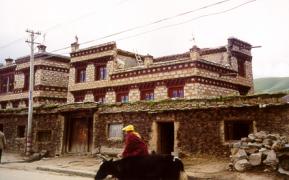
| The old part of town was full of stone houses.
|
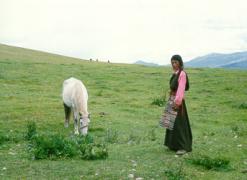
| The hills around Litang are completely covered in wildflowers
in August. These hills and the grasslands below are heavily
grazed by yaks, sheep, and horses.
|
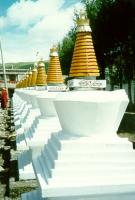
| Stupas
|
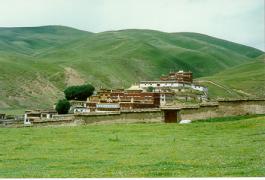
| The large monastery in Litang had the only
old (100-800 years) Tibetan frescoes and thangkas that I had seen in
China. This may be because its inaccessibility spared them
from the Cultural Revolution.
|
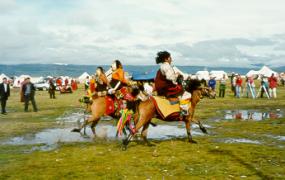
| I went to Litang for the annual horse festival (August 1-15).
Hundreds of Tibetan families pitched tents in the grasslands for
the event. Many were dressed up in traditional costumes, especially
the crazy riders, whose long sleeves flapped as they performed stunts
to impress the crowds.
|
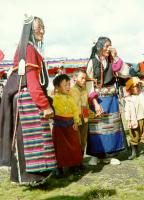
| I was especially impressed by the hair. The Golock women often
had 108 braids under their ornamental headdresses, and the long-haired
Khampa men put their hair up, where it was held by rings of coral
jewelry and mastodon ivory along with a characteristic red or black
tassle.
| 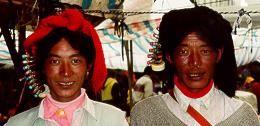
|
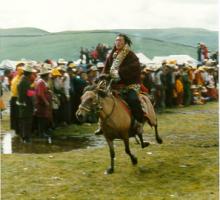
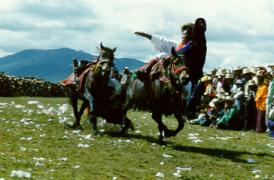
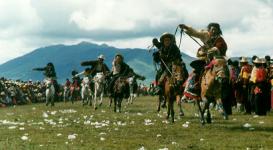
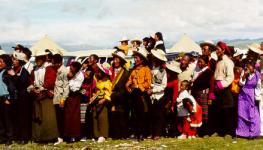
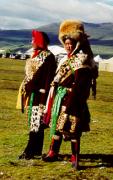
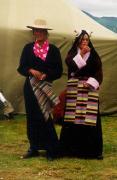
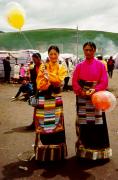
Chengdu

| In the summer, Chengdu is gray, rainy, and hot.
This uncomfortable atmosphere breeds both the famous Sichuan cuisine
and the endangered giant panda.
Chengdu has a Giant Panda Breeding Base, where the most
interesting things were the playful baby pandas, as the
adults don't do much.
The museum had a chart displaying how pandas spent their time -
a few hours eating, followed by a couple of minutes of "play", after
which they trundle off to sleep for a few hours.
|
Guangxi
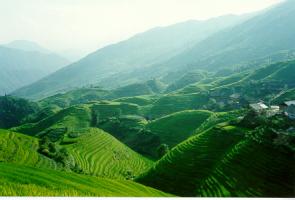
| The Long Ji (Dragon Backbone) rice terraces at Ping An were
surprisingly difficult to reach, despite their tourist appeal and
proximity to Guilin. I took a bus from Guilin to Long Sheng,
hopped out onto the road outside of He Ping, walked to an unlabeled
bus stop in town, then took a bus to Huang Lou. From there, the
bus driver offered to take me (and a couple of other tourists)
up to the terraces for a little extra money. The bus climbed up the
steep hill for a while, and dropped us off into a large crowd of Yao
minority women who followed us up the hill constantly offering to
carry our bags or show us their traditional hair-combing ritual.
The destination was impressive. In the summer, the terraces were
full of rice and other crops. The tourists photos show the terraces
in the spring, when they are shimmering stacked pools of water.
|
Yangshuo
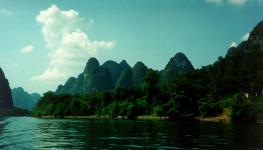
| Yangshuo is the budget alternative to Guilin.
It has the same scenery, and one can even take a Li River cruise
from there.
|
Shanghai
Shanghai is full of skyscrapers, interspersed by fantastic
examples of Art Deco. It is one of the most modern and commercial
cities in China. As I walked the streets, the condensation from
airconditioning units hundreds of feet above fell like a light rain.
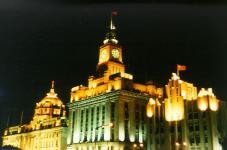
| The early 20th-century architecture of the Bund.
|
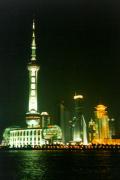
| The modern buildings of the New Bund.
|
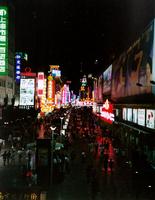
| Shanghai, the next Hong Kong.
|
Bus trips to Litang
| Source
| Dest
| Price
| Duration
|
| Kunming
| Chuxiong
| 30
| <3 hrs
|
| Chuxiong
| Xiaguan
| 41
| 2 hrs
|
| Xiaguan
| Dali
| 1.2
| <1 hr
|
| Dali
| Lijiang
| 35
| 3 hrs
|
| Lijiang
| Zhongdian
|
| 5 hrs
|
| Zhongdian
| Xiangcheng
| 50.50
|
|
| Xiangcheng
| Litang
| 55
| 6 hrs
|
| Litang
| Kanding
| 77
| 7 hrs
|
| Kanding
| Chengdu
| 109
| 7 hrs
|
Links
go back!























 A juniper hearth and prayer flags near a hilltop monastery.
Tibetan Buddhism permeated the atmosphere all around the Tibetan
plateau. Many wore pendants containing a picture of the Panchen
Lama, second only to the Dalai Lama in authority. The Chinese
government supports the Panchen Lama, who lives in Beijing.
The government not only forces the Dalai Lama to live in exile,
his likeness is banned in China. Any photos of the Dalai Lama,
even a photo in your guidebook, is considered contraband and can
get you shipped home (note that newer editions of
guidebooks no longer contain his photo).
This seems to have made the scarce copies
of his image more wondrous. A tourist told me that he was
showing a small crowd of Tibetan men a tiny image of the young
Dalai Lama from his guidebook. When the men finally recognized
the young Lama, they removed their hats and stared at the photo.
I was walking around the grounds of a monastery that was closed,
but an old monk offered to let me into the main building. He
unlocked a tiny room all the way in the back, then flipped on the
lights. At the end of the room was a large poster of the Dalai
Lama from some peace rally, probably in America.
It was ringed by Christmas lights.
Obviously, this room could not be part of the official tour
of the grounds.
A juniper hearth and prayer flags near a hilltop monastery.
Tibetan Buddhism permeated the atmosphere all around the Tibetan
plateau. Many wore pendants containing a picture of the Panchen
Lama, second only to the Dalai Lama in authority. The Chinese
government supports the Panchen Lama, who lives in Beijing.
The government not only forces the Dalai Lama to live in exile,
his likeness is banned in China. Any photos of the Dalai Lama,
even a photo in your guidebook, is considered contraband and can
get you shipped home (note that newer editions of
guidebooks no longer contain his photo).
This seems to have made the scarce copies
of his image more wondrous. A tourist told me that he was
showing a small crowd of Tibetan men a tiny image of the young
Dalai Lama from his guidebook. When the men finally recognized
the young Lama, they removed their hats and stared at the photo.
I was walking around the grounds of a monastery that was closed,
but an old monk offered to let me into the main building. He
unlocked a tiny room all the way in the back, then flipped on the
lights. At the end of the room was a large poster of the Dalai
Lama from some peace rally, probably in America.
It was ringed by Christmas lights.
Obviously, this room could not be part of the official tour
of the grounds.




















